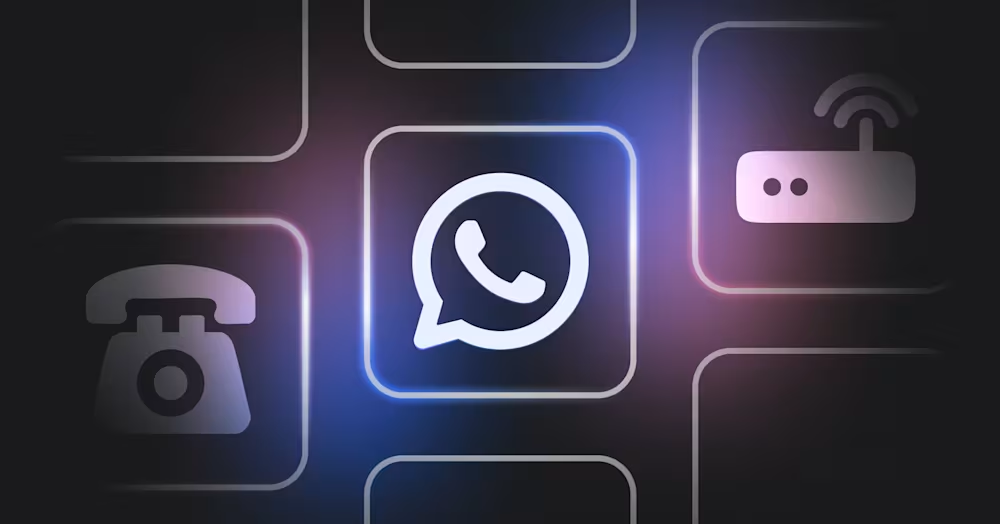
VoIP vs Landline vs WhatsApp Business Calling API
In this article, we'll compare VoIP vs Landline vs WhatsApp Business Calling API to help you decide which one is the best choice for your business.

Apakah Anda sedang mencari Otomasi Obrolan Facebook, untuk Mengotomatiskan Pesan WhatsApp, mengotomatiskan tanggapan yang sudah disiapkan, atau mengotomatiskan obrolan jenis apapun, prinsip-prinsip otomasi pesan selalu sama. Jika Anda terlalu mengotomatiskan percakapan, layanan pelanggan Anda akan menderita, jika Anda kurang mengotomatiskannya, itu akan menghabiskan banyak biaya. Panduan ini membantu untuk mendapatkan otomasi pesan yang tepat.
Seperti halnya setiap upaya yang memiliki potensi penghematan biaya yang tinggi, proses otomasi pesan tidak bisa hanya dihidupkan dan dimatikan seperti saklar lampu. Ini adalah proses mencoba, error, dan optimasi. Sangat penting untuk menjalani proses ini karena mudah untuk mengecewakan pengguna atau pelanggan dalam lingkungan pesan waktu nyata.
Kami telah mengembangkan lima langkah yang perlu diikuti. Untuk mengikuti lima langkah ini Anda akan membutuhkan:
Pelanggan atau pengguna yang akan mengobrol dengan Anda di channel aplikasi pesan
Langkah pertama menuju otomasi pesan adalah memahami obrolan yang dilakukan perwakilan layanan pelanggan dan tenaga penjualan Anda dengan pelanggan atau pengguna Anda.
Tujuan dari langkah ini adalah untuk mendapatkan gambaran kasar tentang potensi manfaat yang dapat Anda capai dengan mengotomatiskan beberapa percakapan.
Untuk riset awal, tanyakan kepada tim pengembangan bisnis, departemen penjualan, dan perwakilan pelanggan untuk data anekdotal. Anda akan terkejut betapa terganggunya karyawan mengenai pesan yang berulang.
Catat jawaban yang diberikan karyawan untuk pertanyaan-pertanyaan ini:
Apa pesan atau pertanyaan pertama yang paling umum mereka terima dalam obrolan? Kita sebut ini pesan onboarding.
Apa masalah paling umum yang dijawab oleh tim dukungan pelanggan Anda bagi pelanggan atau pengguna yang sudah pernah mengobrol dengan perusahaan Anda? Kita sebut ini Pertanyaan yang Sering Ditanyakan (FAQ)
Seberapa sering tanggapan yang diberikan untuk baik pesan onboarding atau FAQ persis sama?
Pada tahap ini, Anda akan memiliki gambaran yang cukup baik tentang topik mana yang harus Anda teliti lebih lanjut dengan melihat percakapan obrolan yang lalu. Percakapan masa lalu akan membantu Anda memahami di mana onboarding otomatis dan tanggapan otomatis dapat berguna.
Langkah kedua menuju otomasi obrolan yang praktis melibatkan menemukan bagian-bagian dari percakapan yang dapat Anda otomatisasikan menggunakan aturan otomasi obrolan (untuk Pesan Onboarding) atau AI (untuk FAQ). Untuk melakukannya, temukan obrolan sampel tentang pesan onboarding & FAQ yang Anda pelajari dari tim Anda di Langkah 1.
Cara terbaik untuk menemukan sampel pesan onboarding dan FAQ adalah dengan melihat langsung obrolan. Anda mungkin mencoba untuk melihat email untuk menemukan informasi ini, tetapi percakapan email tidak akan berguna karena cara orang menulis dalam obrolan waktu nyata sangat berbeda dari email.
Jika Anda telah mengatur obrolan langsung di situs web Anda, memeriksa percakapan tersebut adalah tempat yang sangat baik untuk memulai. Jika Anda telah mengatur akun bisnis aplikasi pesan, Anda akan dapat menemukan catatan obrolan Anda di tempat-tempat berikut:
WhatsApp: semua percakapan dicatat di Aplikasi Bisnis WhatsApp
WeChat: semua percakapan dicatat di Platform Akun Resmi WeChat
Line: semua percakapan dicatat di aplikasi obrolan 1 ke 1 Line@
Setelah Anda mendapatkan sekitar 10 hingga 20 contoh percakapan obrolan untuk setiap pesan onboarding & FAQ yang ingin Anda otomatisasikan, Anda siap untuk langkah berikutnya.
Ubah percakapan pelanggan menjadi pertumbuhan bisnis dengan respond.io. ✨
Kelola panggilan, obrolan, dan email di satu tempat!
Untuk sebagian besar bisnis, kami melihat beberapa pertanyaan atau topik yang sangat umum sehingga sebaiknya diantisipasi untuk semua kontak baru (pelanggan).
Otomasi onboarding membantu menyambut kontak baru ke dalam percakapan. Ini bisa menjadi pesan untuk mendidik kontak tentang masalah atau pertanyaan yang dapat dijawab oleh kontak sehingga Anda dapat membantu mereka lebih cepat.
Saat memilih jenis pesan yang akan dikirim atau pertanyaan yang akan diajukan dengan otomasi onboarding pertama Anda, pertimbangkan matriks otomasi obrolan di bawah ini.

Pastikan untuk mulai mengotomatiskan pesan di mana Anda memiliki kemungkinan tinggi untuk benar dan biaya rendah untuk salah.
Eksperimen pertama kami hanya satu pertanyaan sederhana. Bahasa apa yang Anda lebih suka untuk mengobrol dalam Bahasa Inggris, Spanyol, atau Mandarin? Sangat mudah untuk membuat otomasi onboarding sederhana seperti ini untuk perusahaan Anda.
1. Navigasikan ke Pengaturan > Tambah Bidang dan buat bidang dengan bahasa yang diinginkan kontak.
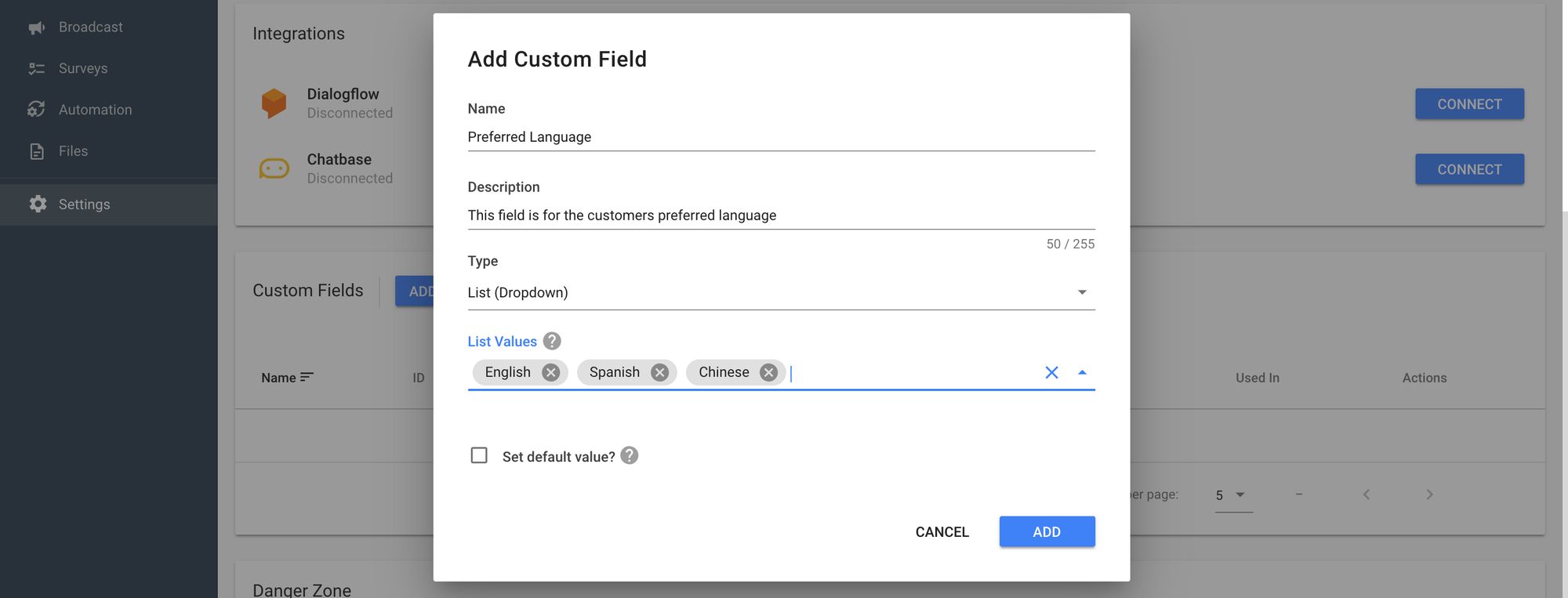
2. Navigasikan ke Survei > Tambah Survei dan buat survei untuk menanyakan kepada kontak bahasa yang mereka inginkan.
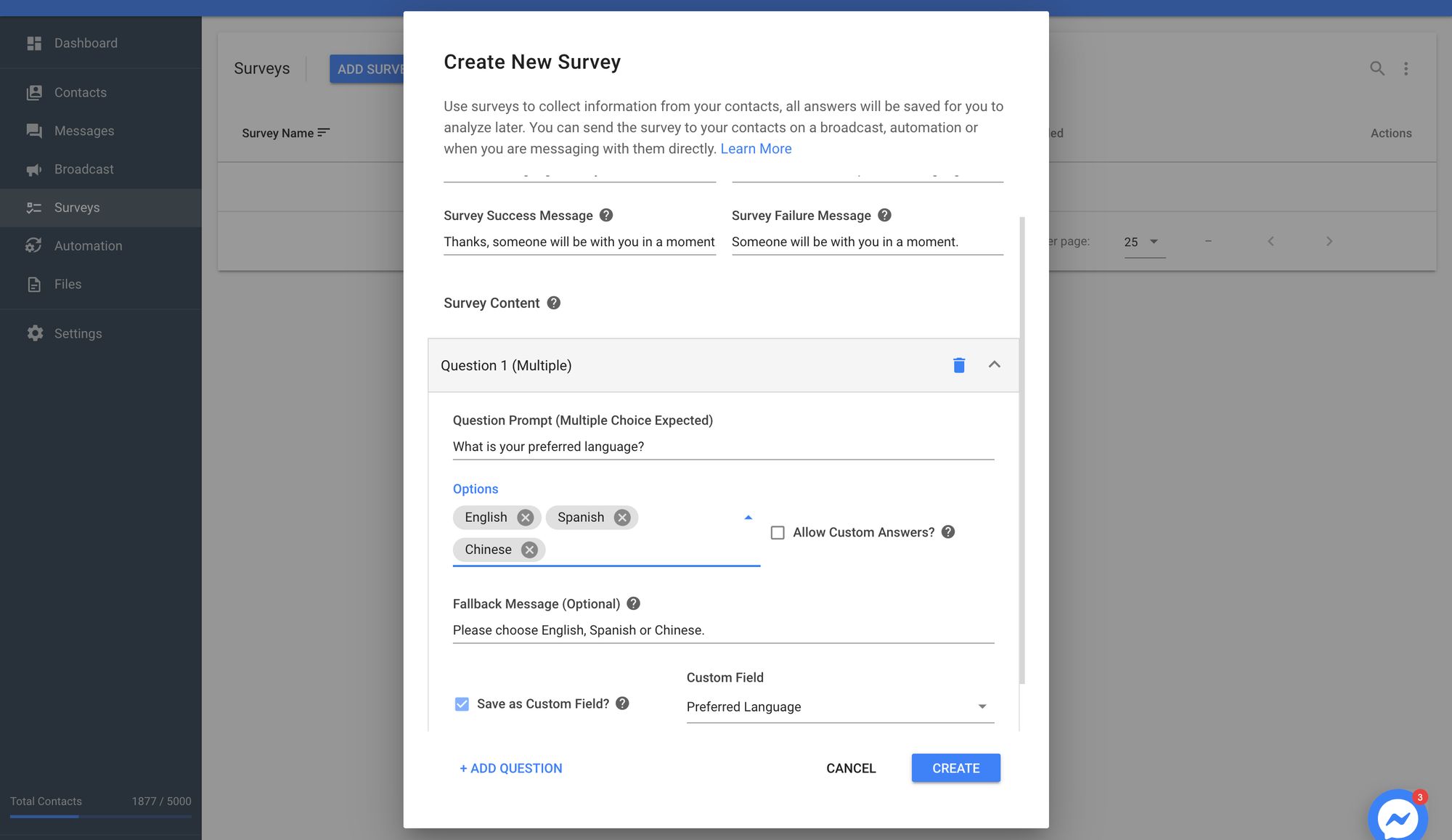
3. Navigasikan ke Otomasi > Tambah Aturan dan Buat Aturan yang mengirim survei kepada kontak saat mereka memulai percakapan.
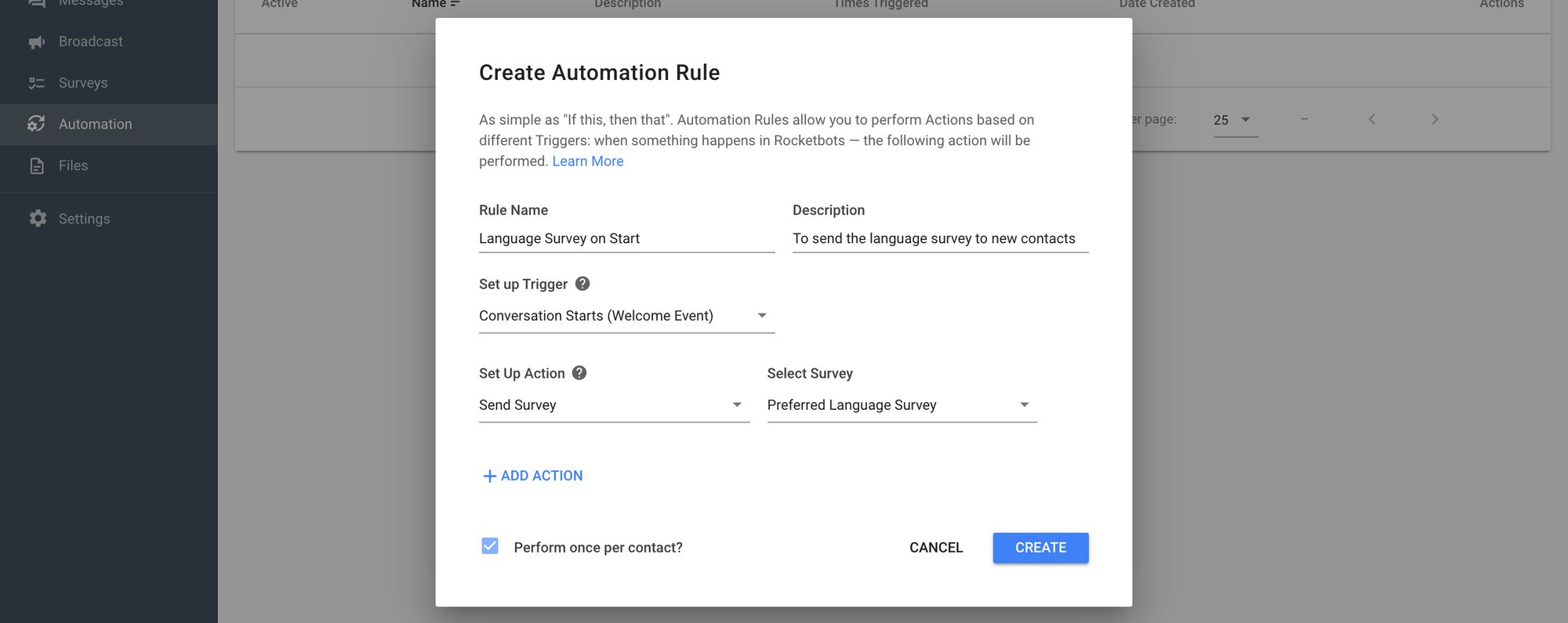
4. Navigasikan ke Otomasi > Tambah Aturan dan buat aturan yang menetapkan kontak kepada salah satu pengguna platform Respond.io Anda tergantung pada bahasa yang mereka pilih.
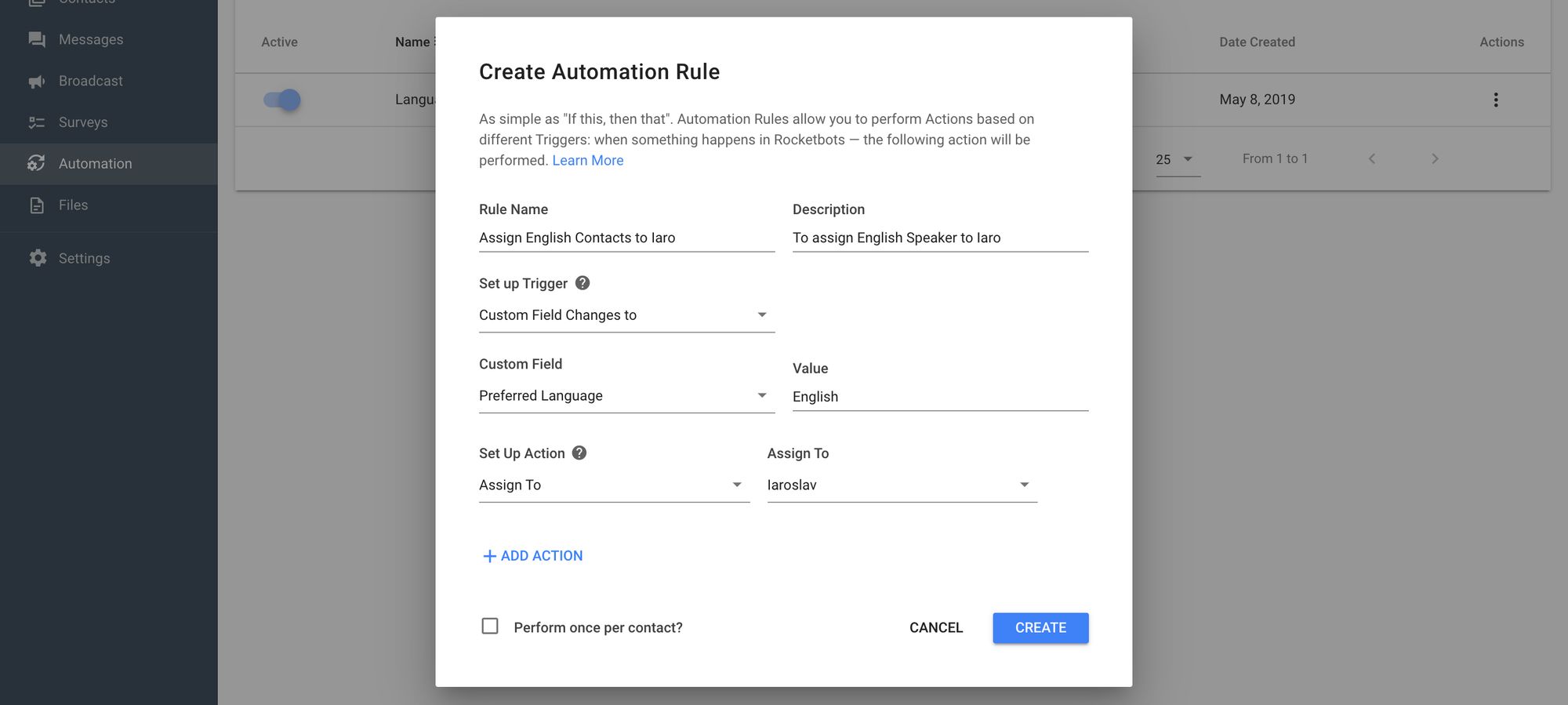
Itu saja. Anda telah membuat otomasi pertama Anda.
Sebuah kata peringatan, kami melakukan eksperimen pertama kami dengan otomatisasi onboarding di lingkungan tertutup yang tidak melibatkan pengguna nyata kami. Namun, kami dengan cepat belajar bahwa metode ini membuang waktu tim kami (mereka adalah penguji) dan biasanya tidak mencerminkan apa yang sebenarnya terjadi di dunia nyata. Eksperimen terlebih dahulu dengan otomatisasi yang sangat ringan, seperti yang telah kami jelaskan di atas dan uji pada kontak nyata Anda.
Jika Anda siap untuk sesuatu yang lebih kompleks, kami juga telah membuat panduan untuk otomasi onboarding yang kompleks.
Sekarang Anda telah melakukan beberapa otomasi onboarding kontak, mari kita buat beberapa tanggapan yang sudah disiapkan dan otomatisasikan tanggapan tersebut.
Setelah Anda meninjau log obrolan Anda dan memiliki gambaran yang baik tentang pertanyaan yang sering diajukan, saatnya untuk membuat tanggapan yang sudah disiapkan. Ini adalah tes untuk melihat apakah tanggapan Anda bisa diotomatisasi. Jika agen Anda merasa tanggapan yang sudah disiapkan cukup, maka itu berhasil.
Dalam kasus kami, pertanyaan yang paling umum adalah tentang menghubungkan saluran. Orang-orang akan bertanya, bagaimana cara saya menghubungkan WhatsApp dengan platform Anda? Bagaimana cara saya menghubungkan Line dengan platform Anda? Jawaban yang kami berikan untuk pertanyaan-pertanyaan ini sederhana, kami mengarahkan mereka ke dokumentasi.
Cara terbaik bagi Anda untuk mulai menguji tanggapan yang sudah disiapkan adalah dengan membuat Snippet di platform Respond.io. Snippet adalah nama kami untuk tanggapan yang sudah disiapkan, Snippet yang Anda buat dapat digunakan oleh agen untuk menjawab pertanyaan.
Untuk membuat Snippet navigasikan ke Snippet > Tambahkan Snippet.
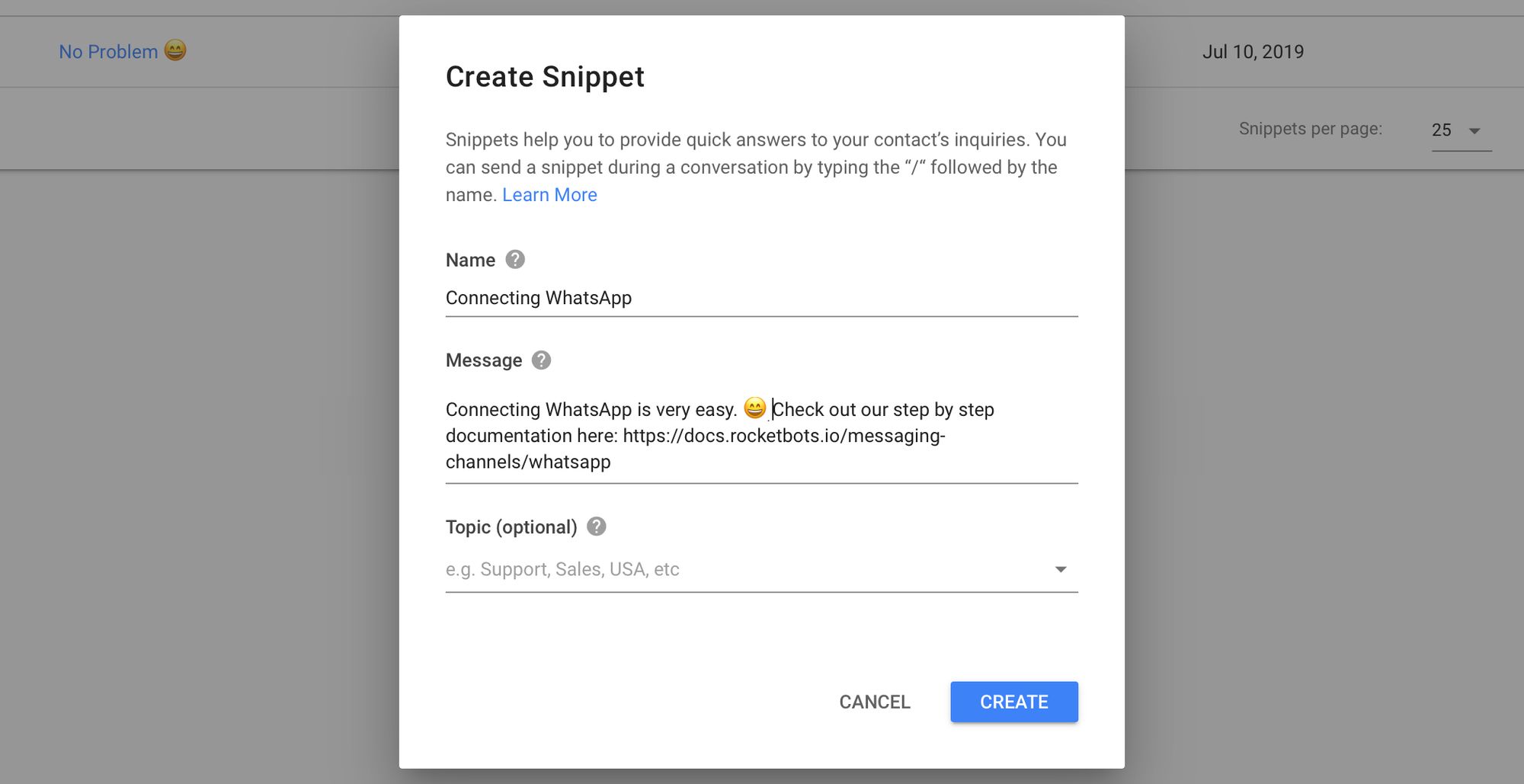
Snippet memiliki nama, pesan, dan topik. Nama digunakan untuk memunculkan Snippet menggunakan perintah "/" dalam modul pesan. Pesan adalah teks yang dikirim ke kontak. Topik bersifat opsional tetapi membantu menjaga keteraturan setelah Anda memiliki banyak Snippet.
Untuk menggunakan perintah Snippet navigasikan ke modul Pesan > ketik "/" > pilih Snippet dengan mengetik nama atau menggunakan panah atas & bawah > tekan Enter.
Menggunakan Snippet sama mudahnya seperti menggunakan tanggapan yang sudah disiapkan di platform lainnya. Setelah Anda membuat 10 hingga 20 Snippet yang menurut Anda akan bekerja, saatnya untuk membiarkan agen Anda mencobanya. Ini adalah langkah penting sebelum Anda memulai otomatisasi FAQ.
Setelah Anda memiliki 10 hingga 20 Snippet yang berfungsi dengan baik dengan agen, ini berarti Anda siap untuk menambahkan otomatisasi FAQ ke dalam campuran. Di sinilah Processor Bahasa Alami (NLP) seperti Dialogflow berperan.
Jangan khawatir tentang nama yang rumit. NLP adalah perangkat lunak yang menggunakan sedikit AI untuk menentukan seberapa dekat satu frasa dengan yang lain. Setiap kali seseorang mengajukan pertanyaan, itu akan membandingkannya dengan pertanyaan yang telah Anda tambahkan untuk tanggapan yang sudah disiapkan.
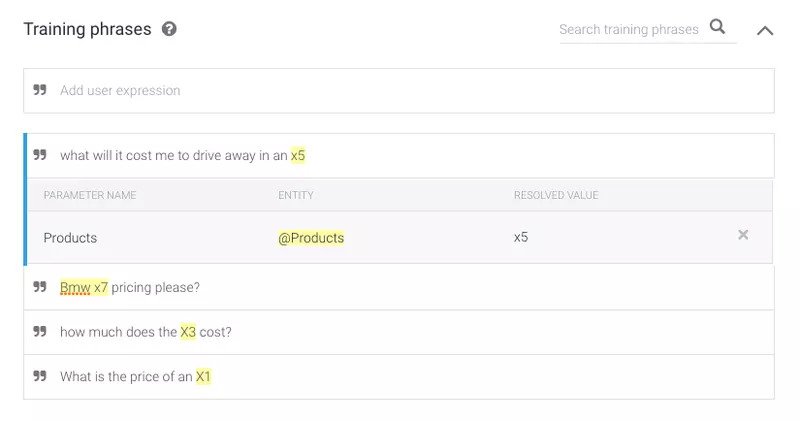
Jika Anda tertarik untuk mempelajari lebih lanjut tentang penggunaan Dialogflow untuk beberapa otomatisasi FAQ dengan respond.io, silakan lihat posting kami tentang menggunakan platform bersama Dialogflow. Ada banyak tip dan trik untuk dicoba.
Tidak ada yang mengharapkan Anda benar pada percobaan pertama. Otomasi obrolan adalah proses percobaan dan kesalahan yang mengharuskan organisasi untuk menguji varian jawaban mereka yang lebih baik secara berulang dan menganalisis umpan balik konsumen terhadap obrolan otomatis untuk meningkatkan desain mereka. Anda ingin mengoptimalkan onboarding Anda dan meningkatkan cara Anda mengelompokkan informasi dalam Snippet untuk benar-benar mengotomatiskan tanggapan yang telah disiapkan.
Kunci untuk sistem otomasi obrolan yang berhasil adalah kemampuan organisasi untuk mencatat, mengevaluasi, dan meningkatkan, berdasarkan temuan mereka.
Ubah percakapan pelanggan menjadi pertumbuhan bisnis dengan respond.io. ✨
Kelola panggilan, obrolan, dan email di satu tempat!
Ingin belajar lebih lanjut tentang otomasi obrolan? Baca artikel-artikel ini untuk saran praktis dan contoh.
Iaroslav Kudritskiy adalah Chief Operating Officer dan salah satu pendiri respond.io, yang mengawasi pertumbuhan dan operasi. Ia lulusan program MBA di Universitas Cina Hong Kong dan jabatan sebelumnya meliputi posisi di Kodak Alaris, Xaxis dan Light Reaction.

In this article, we'll compare VoIP vs Landline vs WhatsApp Business Calling API to help you decide which one is the best choice for your business.